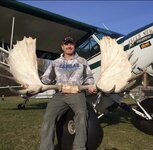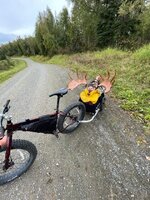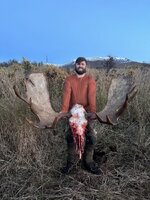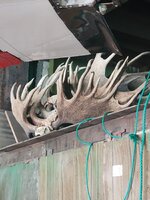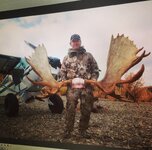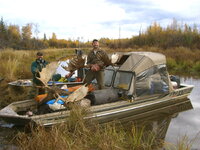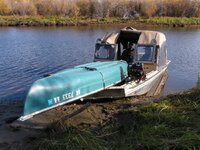Troy Sessions
FNG
This topic is the most overlooked and biggest reason why folks are not successful in harvesting giant moose in the 60" plus range.
Very few people know this. The BEST TIME to scout for giant moose is after the hunting season closer... I’m not kidding...
Ask yourself why Fish and game and area biologists do all their moose counts in October or later. It's when all the moose have gathered up their harem and are rutting hard plus the leaves have fallen off the trees to see the moose better.
How did I find out about this? My mentor (pilot mentor) who I considered my second father since the 1990’s was a retired Fish and Game officer back in the 1940s-50s and 60s and later Alaska "Master Guide". Bucko, “who took me under his wing” was also instrumental in getting the very first SuperCub airplanes for Fish and Game and later chosen to be a speaker for Alaska and represent Alaska back in Washington DC.
The one phrase I have heard many times over the years is, “This area looks moosy”. It’s also the biggest reason why most people are not successful in harvesting giant bulls (over 60”). I have seen those kinds of areas myself and think the same thing. The fact of the matter is these areas are found in the summertime or early fall where the bulls will not be during the rut. However great for harvesting small meat bulls they are seldom good for the giants.
Seeing tracks, wallows, natural salt licks, and mushy moose droppings suggest where they are during the summer. When you find branches broken over or the bark is rubbed off five feet up on the surrounding trees indicates “rutting grounds” and suggest where the moose winter after the rut and this is what you are looking for.
After the hunting season, scouting is much different from “pre season' scouting, During this time I want to SEE THE GIANT BULLS and their harems. I’m not out there looking for signs anymore. All I care about is seeing the big bulls and figuring out how I can get in on them next fall. You can do this by getting high up the mountains climbing up bluffs or spending time in big trees overlooking new areas, glassing is the name of the game. It’s all about elevation and getting eyeballs on the targeted species. As simple as it sounds that's all you have to do. It’s spot and stalking except you have to wait until next year to stalk.
Once I have figured out logistics the next thing to do is keeping the pack job down to a minimum.
Just because you find a 70" bull weighing in around 1700 lbs high up on the mountain side doesn’t mean you should shoot him there. In fact, I’m here to desperately tell you NOT to shoot the bull in an area that could be impossible to pack out. This is when knowing how to call moose from miles away enticing hime to you comes into play. I will save that topic for another time.
I will share another secret for all of you to keep a mental note of. When you do find a giant bull /bulls with a large harem the likeliness of that bull being in that same spot next year is almost guaranteed. Most bulls rut within 1 mile in the same area year after year.
Big harems usually hold 3-5 other bulls “not seen” waiting back 300 plus yards in the bush until almost dark to sneak in and breed the cows while the biggest bull is preoccupied.
Long story short, all these cows and bulls were taught to rut in that location. The only time this isn’t true is when there has been a big fire in the area or when wolves or bears take over an area causing major winter kill.
For non-residents, elevation is still the name of the game and will lend itself helpful during your hunt.
This is the first time I have ever disclosed this information in public, Knowing this will most likely up Alaska’s 21% harvest success rate for DIY hunters.
I hope this helps you all on your next moose hunt.
Troy Sessions
Very few people know this. The BEST TIME to scout for giant moose is after the hunting season closer... I’m not kidding...
Ask yourself why Fish and game and area biologists do all their moose counts in October or later. It's when all the moose have gathered up their harem and are rutting hard plus the leaves have fallen off the trees to see the moose better.
How did I find out about this? My mentor (pilot mentor) who I considered my second father since the 1990’s was a retired Fish and Game officer back in the 1940s-50s and 60s and later Alaska "Master Guide". Bucko, “who took me under his wing” was also instrumental in getting the very first SuperCub airplanes for Fish and Game and later chosen to be a speaker for Alaska and represent Alaska back in Washington DC.
The one phrase I have heard many times over the years is, “This area looks moosy”. It’s also the biggest reason why most people are not successful in harvesting giant bulls (over 60”). I have seen those kinds of areas myself and think the same thing. The fact of the matter is these areas are found in the summertime or early fall where the bulls will not be during the rut. However great for harvesting small meat bulls they are seldom good for the giants.
Seeing tracks, wallows, natural salt licks, and mushy moose droppings suggest where they are during the summer. When you find branches broken over or the bark is rubbed off five feet up on the surrounding trees indicates “rutting grounds” and suggest where the moose winter after the rut and this is what you are looking for.
After the hunting season, scouting is much different from “pre season' scouting, During this time I want to SEE THE GIANT BULLS and their harems. I’m not out there looking for signs anymore. All I care about is seeing the big bulls and figuring out how I can get in on them next fall. You can do this by getting high up the mountains climbing up bluffs or spending time in big trees overlooking new areas, glassing is the name of the game. It’s all about elevation and getting eyeballs on the targeted species. As simple as it sounds that's all you have to do. It’s spot and stalking except you have to wait until next year to stalk.
Once I have figured out logistics the next thing to do is keeping the pack job down to a minimum.
Just because you find a 70" bull weighing in around 1700 lbs high up on the mountain side doesn’t mean you should shoot him there. In fact, I’m here to desperately tell you NOT to shoot the bull in an area that could be impossible to pack out. This is when knowing how to call moose from miles away enticing hime to you comes into play. I will save that topic for another time.
I will share another secret for all of you to keep a mental note of. When you do find a giant bull /bulls with a large harem the likeliness of that bull being in that same spot next year is almost guaranteed. Most bulls rut within 1 mile in the same area year after year.
Big harems usually hold 3-5 other bulls “not seen” waiting back 300 plus yards in the bush until almost dark to sneak in and breed the cows while the biggest bull is preoccupied.
Long story short, all these cows and bulls were taught to rut in that location. The only time this isn’t true is when there has been a big fire in the area or when wolves or bears take over an area causing major winter kill.
For non-residents, elevation is still the name of the game and will lend itself helpful during your hunt.
This is the first time I have ever disclosed this information in public, Knowing this will most likely up Alaska’s 21% harvest success rate for DIY hunters.
I hope this helps you all on your next moose hunt.
Troy Sessions

